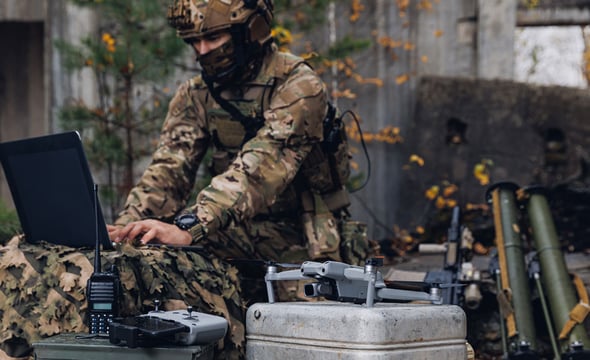
In the complex world of modern military operations, effective use of the electromagnetic spectrum is paramount. Joint Electromagnetic Spectrum Operations (JEMSO) cells are the custodians of this realm, responsible for optimizing spectrum usage in a theater of war. A vital aspect of their mission is educating their commanders on spectrum usage, ensuring that all electronic systems operate harmoniously to achieve mission success.
Here are ten ways a JEMSO cell can proactively educate their commander to ensure victory within a contested electromagnetic spectrum.
1. Collect relevant information
To begin the educational process, JEMSO personnel must begin by collecting comprehensive data on the current spectrum environment in the theater of war. This includes information on the electronic systems employed by friendly and enemy forces, frequencies in active use, and potential electronic warfare (EW) threats. Sources for this data come from intelligence reports, spectrum monitoring equipment, and liaising with other units and allies. JEMSOs can communicate this information by issuing relevant guidance and routine reporting.
2. Analyze and prioritize spectrum requirements
To advise the commander effectively, the JEMSO cell must perform a meticulous analysis of the spectrum requirements for all units operating in the theater. The analysis should include communication needs, radar systems, EW capabilities, and other electronic equipment used by friendly, enemy, and civilian forces. Prioritizing requirements is key, and they should be aligned with mission objectives to guarantee that essential systems access the required spectrum.
The JEMSO cell must also ensure that the Joint Restricted Frequency List (JFRL) is a living document.
3. Assess threats
The JEMSO cell must assess potential spectrum-related threats posed by enemy forces. This assessment should cover several areas, including identifying enemy EW capabilities, logging jamming attempts, and devising strategies for countering these threats. Additionally, the JEMSO cell should evaluate the vulnerability of friendly forces to enemy interference.
4. Spectrum management and deconfliction
The JEMSO cell's responsibility includes managing and deconflicting spectrum use. To ensure that the commander is well-informed, the cell should provide detailed plans for coordinating and de-conflicting frequencies and electronic systems. This is critical to avoid interference and maintain operational effectiveness. Plans should establish frequency charts and prevent conflicting frequency assignments.
5. Strategies for electronic warfare
The JEMSO cell should explain to the commander how they intend to employ electronic warfare techniques. Actions could include disrupting or degrading the enemy's electronic systems while safeguarding friendly systems. The commander should be apprised of strategies for electronic attack (jamming), electronic protection (shielding), and electronic support (gathering targetable data).
The JEMSO cell must depend on its subordinate joint task force cyber electromagnetic activities (JTF CEMA) cells to provide EW capabilities and concept of operations (CONOPs) for planning.
6. Reporting and feedback mechanisms
The JEMSO cell must establish transparent reporting mechanisms, ensuring that the commander receives real-time updates on the spectrum environment. A feedback loop should be created to facilitate adjustments in spectrum allocation and management in response to changing operational conditions. JEMSOs should be linked to the Operational Assessment division and its processes. Lessons learned must be recorded, and the Joint EW Center (JEWC) should be informed.
7. Promote training and awareness
The JEMSO cell can collaborate with training and operations staff to ensure spectrum management is integrated into training exercises and operational procedures. JEMSOs must work to ensure real EW effects are used in training rather than “white carding” EW techniques.
All personnel should be made aware of the significance of spectrum management and its impact on mission success—before a war begins.
8. Legal and regulatory compliance
The commander should be fully briefed on the legal and regulatory aspects of spectrum usage, including compliance with international agreements and national regulations. Understanding these dimensions is vital to avoid unintended legal repercussions. Education on Operational Law and communication with the Judge Advocate General is paramount.
9. Risk assessment and mitigation
JEMSO personnel should, with the commander, collaboratively assess risks tied to spectrum usage. Together, they should work on crafting strategies to mitigate these risks, including contingency plans for spectrum disruptions. There should also be a thorough understanding of how these disruptions might impact mission success.
10. Developing requirements for the future fight
While JEMSOs focus on the operational and current fight, they must include EMSO equities in the requirements processes, including Joint Emerging Operational Needs (JEONs), Joint Urgent Operational Needs Statements (JUONS), and Integrated Priority Lists (IPLs).
JEMSO cells must also promote this forward-thinking approach within their Cyber Electromagnetic Activities (CEMA) cells. It is crucial for these CEMA cells to identify any gaps in their capabilities or staffing. Once these gaps are identified, the cells should work towards addressing them. This could involve purchasing commercially available off-the-shelf (COTS) equipment or hiring contractors.
Conclusion
The JEMSO cell plays a pivotal role in educating the commander about spectrum usage in a theater of war. Effective communication and collaboration with the commander are essential to optimize spectrum usage for mission success, preserving the integrity of electronic systems in a complex and contested electromagnetic environment.
Zac George
Zac George is the International Business Development Manager for CRFS. He is a former naval Electronic Warfare officer and also has experience in digital decoding. He speaks regularly on EW and spectrum topics globally, and lives in Switzerland.

